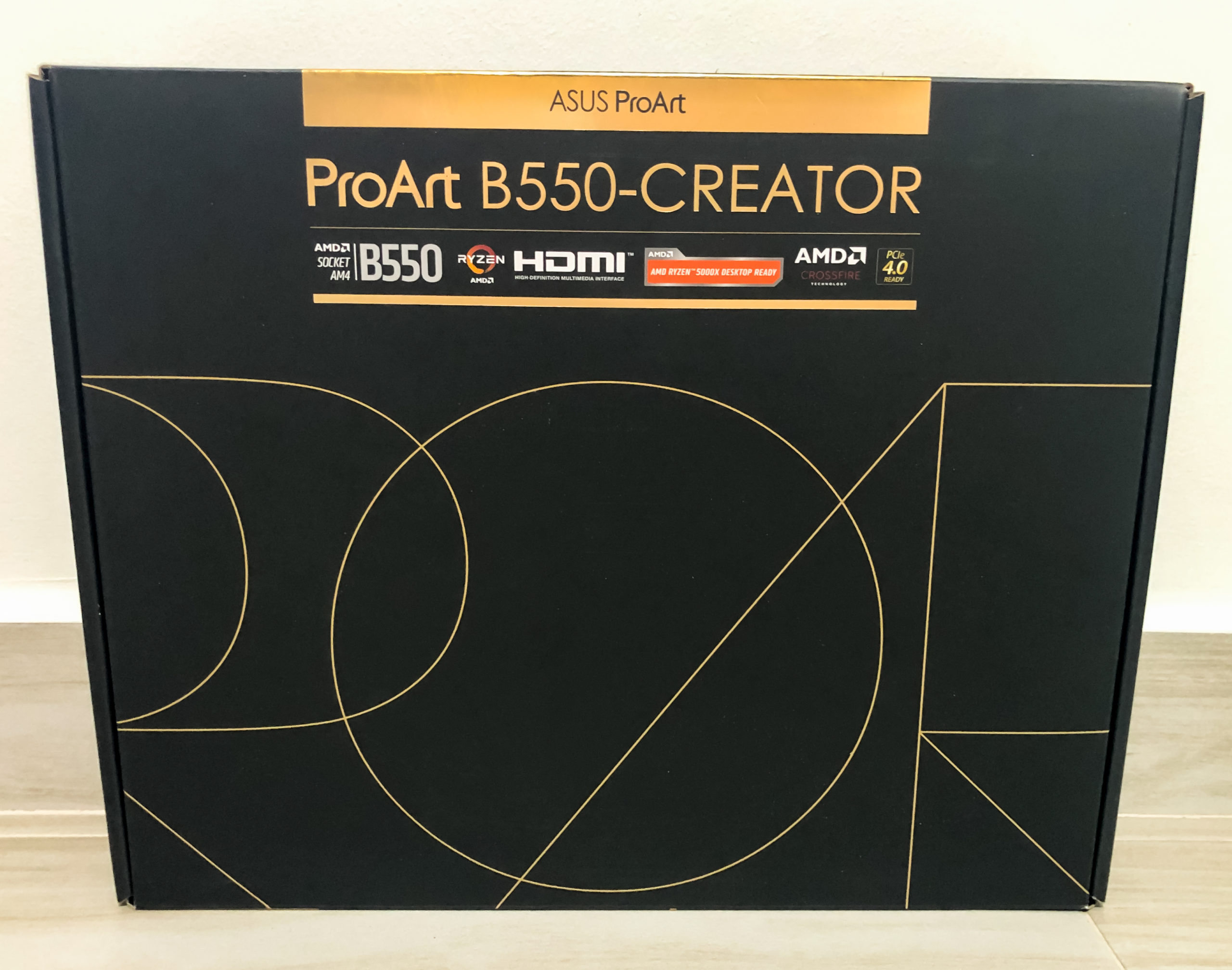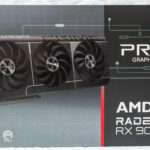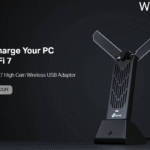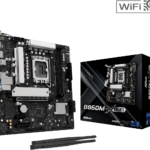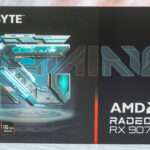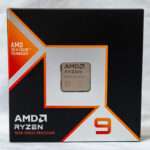Asus ProArt B550- Creator is a represent another new segment of creativity series. This is a highly sophisticated motherboard with support for AMD Ryzen Zen 2 & Zen 3 processors, designed for creativity professionals. It has 15 USB ports of various types, including 4 very fast USB 3.2 Gen2 ports, of which two support Thunderbolt 4, and one of the fastest USB 3.2 Gen2 × 2 ports, albeit in the form of an internal Type-C. The board also provides 3 PCIe x16 slots, 2 PCIe x1 slot, 2 M.2 slots (two of them can be connected to the processor). The board also has 4 SATA ports and 7 fan connectors, two wired 2.5 Gbps LAN. The board has a competent cooling system for each potentially heating element, including drives in M.2 slots (there are thermal pads for cooling drives on both sides). Thunderbolt 4 support allows you to transfer data at 40 Gbps. Of course, Asus ProArt – Creator offers ample opportunities for overclocking enthusiasts in the form of hardware chips, as well as many settings in BIOS Setup and proprietary utilities.
- Dismantle
- The scheme of the chipset + processor bundle operation
- How We Test ASUS ProArt B550- Creator
- CPUZ & GPUZ: ProArt B550 – Creator
- PCMark 10
- Cinebench R2.0
- 3Dmark Advanced Edition
- PassMark Performance Test 10.1 Build 1003
- BaseMark GPU
- Final Fantasy XIV: Shadowbringers Benchmark 1080P DirectX 11
- Monster Hunter Online Benchmark
- ProArt B550 Creator
- Pros
- Cons

USB ports, network interfaces, I / O
On the back I/O panel of connections including 1x PS/2, 1x HDMI 2.0b (iGPU), 1x DisplayPort in (Thunderbolt 4), 2x USB-A 3.2 Gen2 (10Gb/s), 2x USB-A 2.0 (480Mb/s), 2x Thunderbolt 4 (Intel JHL8540), 2x 2.5GBase-T (Intel I225-V), 5x audio jack, 1x Toslink. Also present on the rear panel feature for the bios flashback is included.

2x USB 2.0 ports implemented via Genesys Logic GL852G controller

Intel I225-V B3 2.5Gb network interface, equipped with two on the motherboard

CYPD5225-96BZXI, Type-C interface controller

Intel JHL8540 Thunderbolt 4 chip, output f Thunderbolt 4 ports on the back of the I/O

IT66317, HDMI signal control chip

HD3SS214, responsible for DP input of I/O

Let’s move on to examining our motherboard. The Creator series, already have both top-end X570 chipsets and B550 mid-budget ones. Our current review board belongs mid-budget series – ProArt B550-Creator. ASUS ProArt B550 boards are based upon 14 power phases (12+2), there are 12 phases at 90A are reserved for the CPU and 2x90A for the Mosfet SoCs. The power stages are all cooled by aluminum heat sinks.

The PCIe x16_1 & 2 slot has a stainless steel metal reinforcement, which increases reliability (Which can be important in the case of fairly frequent video card changes, but more importantly: such a slot will more easily withstand the bending load in the case of a very heavy graphics card top-level). It also protects the slot from electromagnetic interference. For the first PCI-E slot will support full bandwidth of PCI-E 3/4 and follow by PCI-E x1 3.0, PCI-E x8 3.0, PCI-E x1 3.0 and PCI-E x4 3.0. You will find a total of two M.2 slots on this motherboard all with different key types for different devices. All two slots feature integrated heat spreaders.

Remove all heatsink and I/O case from the motherboard.
As you can see, the chipset is cooled separately from the other heating elements. The two groups of power converters have their own separate heat sinks. Two M.2 modules have their own heatsinks with a thermal interface. They are mounted separately from the large chipset heatsink.

Dismantle

The power circuit design using 12 + 2 + 1: 15 phases – 12 phases processor core, 2 phases – SoC (Ryzen I / O chiplet) and 1 phases DRAM.

Each 14 phases channel for CPU & SOC has a super ferrite coil and a Vishay SiC639 50A MOSFET

In this case the VRM Digi + EPU ASP1106, which is designed for a maximum of 6 phases.

Therefore, the design scheme of programmed phase control without phase doublers is used. Considering that this scheme does not have a proprietary TPU (TurboV Processing Unit) processor, which distributes the on / off phases on older motherboards, a simple parallel circuit is used: 12 phases for the core are converted into 4 (three physical phases go for one on the controller), and 2 more for SoC are converted to 1.
As for the RAM modules, everything is simpler here: a single-phase circuit is implemented on the Vishay mosfets.

The scheme of the chipset + processor bundle operation

Ryzen 3000/5000 processors have a total of 24 I / O lines (including PCIe 4.0). 4 lanes (in this case, turning into PCIe 3.0) are connected to the B550 chipset. Another 16 lines are PCIe slots for video cards. There are 4 lines left: they can be configured by motherboard manufacturers to choose from:
For ASUS ProArt B550-Creator base on Ryzen 5000 & 3000 processor series:
- operation of one NVMe drive x4 (high-speed PCI-E 4.0) & SATA modes – M.2_1 slot
For ASUS ProArt B550-Creator base on B550 chipset:
- operation of one NVMe drive x4 (high-speed PCI-E 3.0) & SATA modes – M.2_2 slot
Ryzen 3000/5000 processors also have built-in 4 USB 3.2 Gen2 ports.
In turn, the B550 chipset supports a total of 18 PCIe 3.0 lanes. Of these, again, 4 are needed for communication with the CPU. There are 14 I / O lines left, of which 4 are occupied by SATA ports, and the remaining 10 lines can be freely configured. It is clear that there will most likely be a shortage of PCIe lines to accommodate all the necessary peripherals, and resources will have to be divided.
The B550 also supports 2 USB 3.2 Gen2 ports, 2 USB 3.2 Gen1 ports, 6 USB 2.0 ports.
Thus, in total from the B550 + Ryzen 3000/5000 tandem, we get:
- 16 PCIe 4.0 lanes for video cards (from the processor);
- 4 PCIe 4.0 lanes from the processor + 10 PCIe 3.0 lanes from the chipset, which can form different combinations of ports and slots (depending on the motherboard manufacturer);
- 4 SATA 6Gb / s ports (from the chipset);
- 6 USB 3.2 Gen2 ports (4 from processor, 2 from chipset);
- 2 USB 3.2 Gen1 ports from the chipset;
- 6 USB 2.0 ports (from the chipset).
Total: 14 USB ports, 4 SATA ports, 14 free PCIe lanes.

In total, the board has 5 PCIe slots: one PCIe x16 (for video cards or other devices), one PCIe x 8, two “short” PCIe x1 (second, fourth) and last PCIe x 4 slot. If I have already told about the first PCIe x16_1 (it is connected to the CPU), then the second PCIe x16_2 (the third in a row) is connected to the B550 and works as much as possible in the x8 mode. It also shares resources with three PCIe x1_1 / 1_2 / 1_3 slots: if any of the latter are occupied, then PCIe x16_2 is in PCIe x1 mode, and if PCIe x1_1 / 1_2 / 1_3 are free, then PCIe x16_2 receives x4, and only then it is possible to organize AMD CrossFire mode from two video cards.

This board has only one full-fledged PCIe x16 slot, its allocation of PCIe lines is unambiguous, so multiplexers are not in demand.
But switching PCIe x16_2 and PCIe x1 slots is necessary, therefore, ASM1480 multiplexers from ASMedia are used for these purposes.

The Audio is controlled by the Realtek ALC1220A audio codec and it also provides audio output up to 7.1.
Nichicon Fine Gold audiophile capacitors are used in the audio circuits of the board.

How We Test ASUS ProArt B550- Creator
ASUS ProArt B550-Creator is a mid range-level motherboard in ASUS B550 segment. As such, our workstation, based on an ProArt B550- Creator motherboard and AMD Ryzen 5 5600G 6cores 12 threads processor. The ram we will be using is G.Skill’s F4-3600C16D- 16GTZNC memory kit. Hynix 512Gb SATA M.2 SSD and Built- in AMD VEGA 7 is used as well to run with benchmark.
We will be using latest AMD Adrenalin 21.8.2 and Windows 11 Professional Preview Build 22000.160.
For the comparison benchmark with ASUS ProArt B550- Creator & ASUS ProArt X570- Creator.
| Motherboard | ||
| Processor | AMD Ryzen 5 5600G | AMD Ryzen 5 5600G |
| Graphics | AMD Radeon RX Vega 7 | AMD Radeon RX Vega 7 |
| Motherboard | ProArt B550 Creator | ProArt X570 Creator |
| RAM | G.Skill’s F4-3600C16D- 16GTZNC | G.Skill’s F4-3600C16D- 16GTZNC |
| Storage | Hynix 512Gb SATA M.2 | Hynix 512Gb SATA M.2 |
| OS | Windows 11 Build 22000.160 | Windows 11 Build 22000.160 |
| Bios | 2423 Release 2021/08/27 | 0402: Release 2021/08/17 |
CPUZ & GPUZ: ProArt B550 – Creator




PCMark 10
It’s measures overall system performance for modern office work using tests based on real-world apps and activities. PCMark 10 is the latest version in Futuremark’s series of industry standard PC benchmarks. PCMark benchmarks measure complete system performance using tests based on real-world apps and activities. In PCMark 10, these tests include everyday tasks like browsing websites, video chat, writing and spreadsheets, photo and video editing, and playing games. This makes it an ideal benchmark for testing all types of Windows PC, from tablets and hybrids to notebooks and desktops.
| Score | Essentials | Digital Content Creation | Productivity | |
| ASUS ProArt B550 Creator | 6485 | 10636 | 6922 | 10055 |
| ASUS ProArt BX570 Creator | 6354 | 10236 | 6923 | 9824 |

Cinebench R2.0
Cinebench is a real-world cross-platform test suite that evaluates your computer’s hardware capabilities.
| CPU “Multi Core” | CPU “Single Core” | |
| ASUS ProArt B550 Creator | 10382 | 1429 |
| ASUS ProArt BX570 Creator | 10393 | 1444 |

3Dmark Advanced Edition
3DMark includes everything you need to benchmark your PC and mobile devices in one app. Whether you’re gaming on a smartphone, tablet, notebook, or a desktop gaming PC, 3DMark includes a benchmark designed specifically for your hardware.
TimeSpy Extreme
| Score | Graphics Score | CPU Score | |
| ASUS ProArt B550 Creator | 1441 | 1265 | 6824 |
| ASUS ProArt BX570 Creator | 1477 | 1296 | 7141 |

FireStrike Extreme
| Score | Graphics Score | Physics Score | Combined Score | |
| ASUS ProArt B550 Creator | 1789 | 1806 | 20974 | 733 |
| ASUS ProArt BX570 Creator | 1794 | 1805 | 22352 | 740 |

Night Raid
| Score | Graphics Score | CPU Score | |
| ASUS ProArt B550 Creator | 17062 | 18332 | 12255 |
| ASUS ProArt X570 Creator | 16707 | 17855 | 12247 |

CPU Profile
| Max Threads | 16 Threads | 8 Threads | 4 Threads | 2 Threads | 1 Threads | |
| ASUS ProArt B550 Creator | 4951 | 5325 | 4225 | 3152 | 1671 | 851 |
| ASUS ProArt X570 Creator | 5433 | 5392 | 4503 | 3300 | 1749 | 887 |

PassMark Performance Test 10.1 Build 1003
PerformanceTest provides you with an overall “PassMark Rating” that has been a standard for quantifying PC performance since 1998.
| Rating | CPU Mark | 2D Graphics Mark | 3D Graphics Mark | Memory Mark | Disk Mark | |
| ASUS ProArt B550 Creator | 6029 | 19693 | 874 | 2944 | 3080 | 26721 |
| ASUS ProArt X570 Creator | 5365 | 19609 | 878 | 3056 | 3084 | 4568 |

BaseMark GPU
Basemark GPU is a professional evaluation tool to evaluate and compare graphics performance across mobile and desktop platforms. Uniquely, it supports all major graphics APIs and operating systems.
*Settings: Medium & DirectX 12
| Overall Score | Average FPS | Minimum FSP | Maximum FSP | |
| ASUS ProArt B550 Creator | 14343 | 143 | 43 | 279 |
| ASUS ProArt X570 Creator | 14869 | 149 | 77 | 327 |

Final Fantasy XIV: Shadowbringers Benchmark 1080P DirectX 11
| Score | |
| ASUS ProArt B550 Creator | 3805 |
| ASUS ProArt X570 Creator | 3837 |

Monster Hunter Online Benchmark
This benchmark tool sports a series of advanced technology including Real Time Rendering, Physical Based Shading, Realistic Vegetation Rendering, NVIDIA PhysX Clothing, NVIDIA Hairworks and NVIDIA HBAO+.
| Score | Average FPS | Minimum FSP | |
| ASUS ProArt B550 Creator | 3321 | 15 | 8 |
| ASUS ProArt X570 Creator | 3386 | 15 | 9 |
